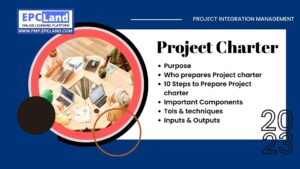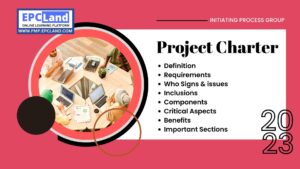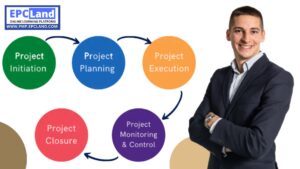Table of Contents
ToggleWhat is Project Charter & It’s important Elements?
A project charter is a document that formally authorizes a project and provides a high-level overview of the project’s objectives, stakeholders, and key deliverables. It acts as a foundation for the project, providing a clear and concise summary of the project’s purpose and goals. The charter is typically created during the initiation phase of a project and is used to communicate the project’s objectives, scope, and goals to stakeholders, team members, and other interested parties.
The project charter typically includes the following elements:
- Project Title: A clear and concise title that summarizes the project’s purpose
- Project Description: A brief overview of the project’s objectives, scope, and deliverables
- Project Manager: The name and contact information of the project manager responsible for the project
- Project Team: A list of key team members, including their roles and responsibilities
- Stakeholders: A list of key stakeholders, including their roles and responsibilities
- Project Scope: A clear and concise statement of the project’s objectives and deliverables
- Project Deliverables: A list of key deliverables that the project is expected to produce
- Project Timeline: A high-level project schedule, including key milestones and deadlines
- Project Budget: An estimate of the project’s budget, including any major expenses and funding sources
- Project Risks: A list of identified risks and potential issues that may impact the project, and the plan to mitigate them.
Attempt Quiz-1 on Develop Project Charter Process

Time's up
What is the Importance of Project Charter
The project charter is an important document that plays a critical role in the success of a project. It serves as a foundation for the project, providing a clear and concise summary of the project’s purpose, goals, and objectives. The charter is used to communicate the project’s scope and deliverables to stakeholders, team members, and other interested parties, and is used to ensure that the project stays on track and within budget and schedule constraints. The importance of project charter can be highlighted as follows:
- It defines the project’s purpose and goals: A project charter clearly defines the project’s objectives, deliverables, and requirements, which helps to ensure that the project stays on track and that all stakeholders are aware of what is expected from the project.
- It acts as a point of reference: The project charter serves as a point of reference throughout the project, and is used to ensure that the project stays on track and that all stakeholders are aware of the project’s objectives and deliverables.
- It helps to establish the project’s boundaries: The project charter helps to establish the project’s boundaries by clearly defining the project’s scope and deliverables, which helps to ensure that the project stays within budget and schedule constraints.
- It helps to secure buy-in from stakeholders: By clearly defining the project’s objectives, deliverables, and requirements, the project charter helps to secure buy-in from stakeholders and ensure that everyone is aware of what is expected from the project.
- It helps to facilitate communication and collaboration: The project charter helps to facilitate communication and collaboration among stakeholders by clearly defining the project’s objectives, deliverables, and requirements, and by establishing a scope change control system that ensures that all stakeholders are aware of any changes to the scope.
- It helps to identify the key stakeholders: A project charter helps to identify the key stakeholders, including their roles and responsibilities, which helps to ensure that all stakeholders are aware of their roles and responsibilities and that communication is clear and effective.
- It helps to identify potential risks: A project charter helps to identify potential risks and potential issues that may impact the project, and the plan to mitigate them.
Who prepares Project Charter?
The project charter is typically prepared by the project sponsor or the project manager, although input and approval may be required from key stakeholders, such as the project team, upper management, and other interested parties.
The project sponsor is typically the individual or group who initiates the project and provides the funding and resources needed to complete it. They have a vested interest in the success of the project and are responsible for ensuring that the project charter is aligned with the overall goals and objectives of the organization.
The project manager is responsible for leading the project and ensuring that it stays on track and within budget and schedule constraints. They work closely with the project sponsor and key stakeholders to develop the project charter and ensure that it is aligned with the overall goals and objectives of the project.
In some organizations, a project charter may be created by a steering committee or project initiation team, which may include representatives from different departments or stakeholders with an interest in the project. The key is that the project charter is created with the input of the key stakeholders and is approved by the project sponsor and other senior management.
The project charter is an important document that establishes the project’s objectives, deliverables, and requirements, and sets the stage for the project’s success. It is important that the project charter is created with the input of key stakeholders and is approved by the project sponsor and senior management.
10 Important Steps to Develop the Project Charter
The steps to develop a project charter typically include:
- Define the project: The first step in developing a project charter is to define the project, including its objectives, deliverables, and requirements. This step involves gathering input from key stakeholders, including the project sponsor, project team, and other interested parties, such as customers and end-users.
- Identify the project sponsor: The project charter should include the name and contact information of the project sponsor, along with a description of their role and responsibilities in the project.
- Define the project manager: The project charter should also include the name and contact information of the project manager, along with a description of their role and responsibilities in the project.
- Identify the project team: The project charter should include a list of the project team members and their roles and responsibilities in the project.
- Identify the project stakeholders: The project charter should include a list of the project stakeholders and their roles and responsibilities in the project.
- Define the project scope: The project charter should include a high-level summary of the project’s objectives, deliverables, requirements, and constraints. This should be done by creating a scope statement that defines the project’s boundaries and what is included and excluded from the project.
- Define the project schedule and budget: The project charter should include a high-level summary of the project schedule, including key milestones and deadlines, and the project budget, including the projected costs and funding sources.
- Identify any constraints and assumptions: The project charter should include information about any constraints or assumptions that will impact the project, such as budget, schedule, and resource constraints.
- Review and approve: The project charter should be reviewed and approved by the project sponsor and other key stakeholders before the project begins. This ensures that everyone is on the same page and has a clear understanding of the project’s objectives, deliverables, and constraints.
Review and update: The project charter should be reviewed and updated throughout the project to ensure that it remains accurate and relevant as the project progresses
Tools & Techniques for Project Charter
There are several tools and techniques that can be used to develop a project charter, some of which include:
- Brainstorming: This technique can be used to generate ideas and gather input from key stakeholders, including the project sponsor and project team.
- Interviews: Interviews can be used to gather input from key stakeholders, including the project sponsor and project team, as well as other interested parties, such as customers and end-users.
- Affinity Diagrams: This tool can be used to organize and categorize ideas and input generated through brainstorming and interviews.
- Flowcharts: Flowcharts can be used to illustrate the project’s objectives, deliverables, and requirements, and to identify potential risks and issues that may impact the project.
- Mind mapping: Mind mapping can be used to organize and categorize ideas and input generated through brainstorming and interviews.
- SWOT analysis: A SWOT analysis (Strengths, Weaknesses, Opportunities and Threats) can be used to identify the internal and external factors that may impact the project and to develop strategies for addressing them.
- Cost-benefit analysis: A cost-benefit analysis can be used to evaluate the potential costs and benefits of the project and to determine whether the project is viable.
- Project management software : Project management software can be used to create a project charter and keep track of the project’s objectives, deliverables, and requirements, as well as the project’s budget, schedule, and risks.
Inputs & Outputs for Project Charter
Inputs for the project charter process include:
- Business case: The business case provides the justification for the project, including its objectives, deliverables, and expected benefits.
- Project statement of work: This document provides a detailed description of the work that needs to be done to achieve the project’s objectives, including the deliverables and requirements.
- Constraints and assumptions: The project charter should include information about any constraints or assumptions that will impact the project, such as budget, schedule, and resource constraints.
- Stakeholder register: This document contains information about the project stakeholders and their roles and responsibilities in the project.
- Organizational process assets: These are the procedures, templates, and guidelines that the organization uses to manage projects.
Attempt Quiz-2 on Develop Project Charter Process

Time's up
Outputs of the project charter process include:
- Project charter: The project charter document is the output of the project charter process. It provides a clear and concise overview of the project’s objectives, deliverables, requirements, and constraints.
- Project sponsorship: The project charter should include the project sponsor’s name, contact information, and a description of their role and responsibilities in the project.
- Project manager: The project charter should also include the name and contact information of the project manager, along with a description of their role and responsibilities in the project.
- Project team: The project charter should include a list of the project team members and their roles and responsibilities in the project.
- Project stakeholders: The project charter should include a list of the project stakeholders and their roles and responsibilities in the project.
- Project management plan: The project charter should include a high-level summary of the project management plan, including the project’s objectives, deliverables, requirements, and constraints.
- Approval: The project charter should be reviewed and approved by the project sponsor and other key stakeholders before the project begins.
FAQs on "Develop Project Charter" in Project Integration Management
FAQs on “Develop Project Charter” in Project Integration Management
What is a Project Charter?
A Project Charter is a document that outlines the purpose, objectives, and stakeholders of a project. It acts as a formal agreement between the project team, sponsor, and stakeholders and defines the roles, responsibilities, and expectations of each party.
What are the elements of a Project Charter?
The elements of a Project Charter typically include the project’s purpose, objectives, scope, deliverables, timeline, budget, stakeholders, and responsibilities.
Why is a Project Charter important?
A Project Charter is important because it provides a clear understanding of the project’s purpose, goals, and expectations, and helps ensure that everyone involved in the project is aligned. It also serves as a reference throughout the project lifecycle and helps resolve disputes by providing a clear definition of the project’s objectives.
Who is responsible for developing a Project Charter?
The Project Manager is typically responsible for developing the Project Charter, with input from the project sponsor and stakeholders.
When should a Project Charter be created?
A Project Charter should be created as early as possible in the project lifecycle, usually before project planning begins. This ensures that everyone involved in the project has a clear understanding of the project’s purpose and goals from the start.
Don’t Miss the 1000+ MCQ questions & hundreds of quizzes on PMP Knowledge Areas and Various important sections.
Similar articles on Project Integration management
Add Your Heading Text Here
Lorem ipsum dolor sit amet, consectetur adipiscing elit. Ut elit tellus, luctus nec ullamcorper mattis, pulvinar dapibus leo.
Add Your Heading Text Here
Lorem ipsum dolor sit amet, consectetur adipiscing elit. Ut elit tellus, luctus nec ullamcorper mattis, pulvinar dapibus leo.
Add Your Heading Text Here
Lorem ipsum dolor sit amet, consectetur adipiscing elit. Ut elit tellus, luctus nec ullamcorper mattis, pulvinar dapibus leo.
Add Your Heading Text Here
Lorem ipsum dolor sit amet, consectetur adipiscing elit. Ut elit tellus, luctus nec ullamcorper mattis, pulvinar dapibus leo.
Add Your Heading Text Here
Lorem ipsum dolor sit amet, consectetur adipiscing elit. Ut elit tellus, luctus nec ullamcorper mattis, pulvinar dapibus leo.






















